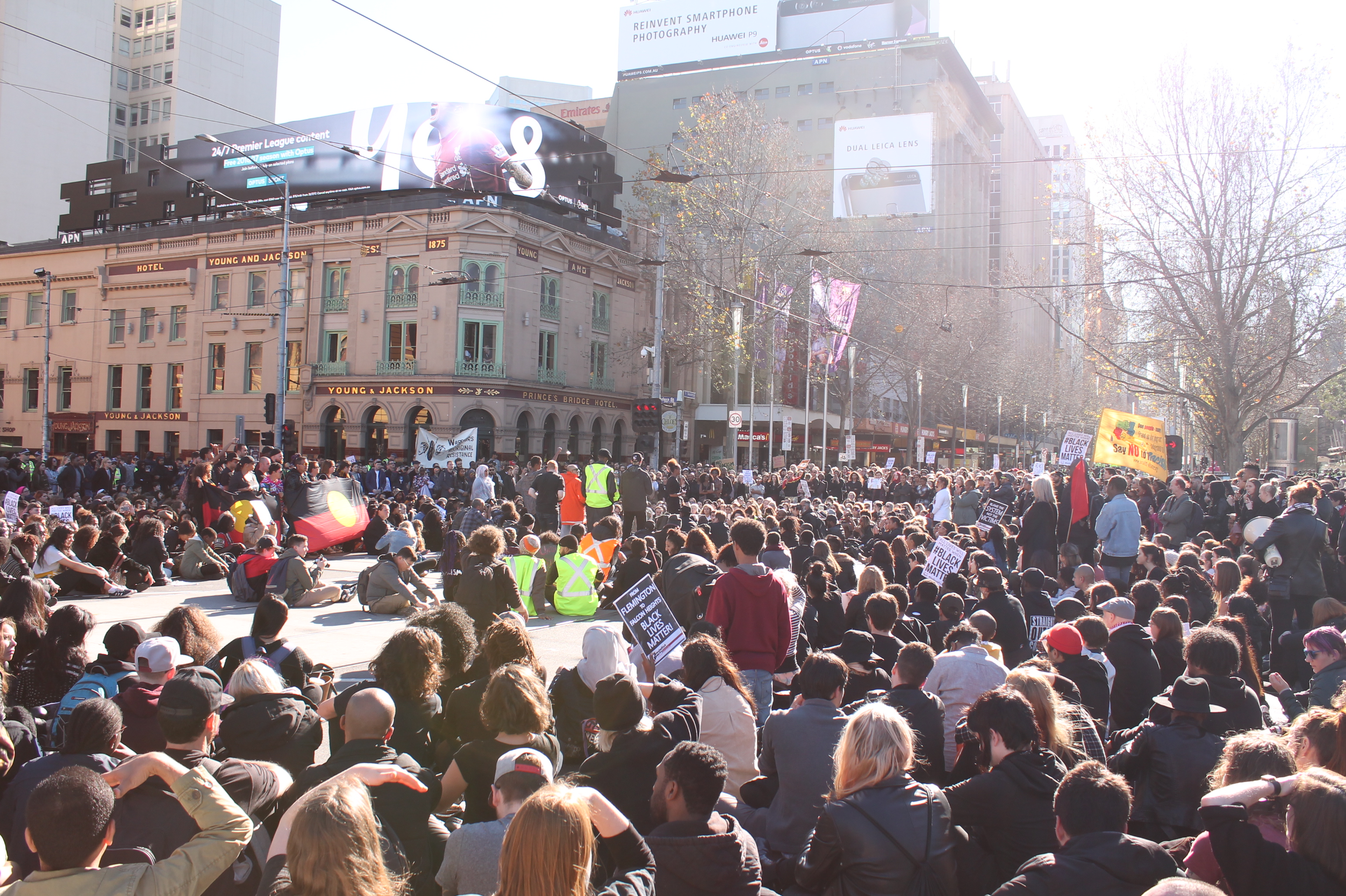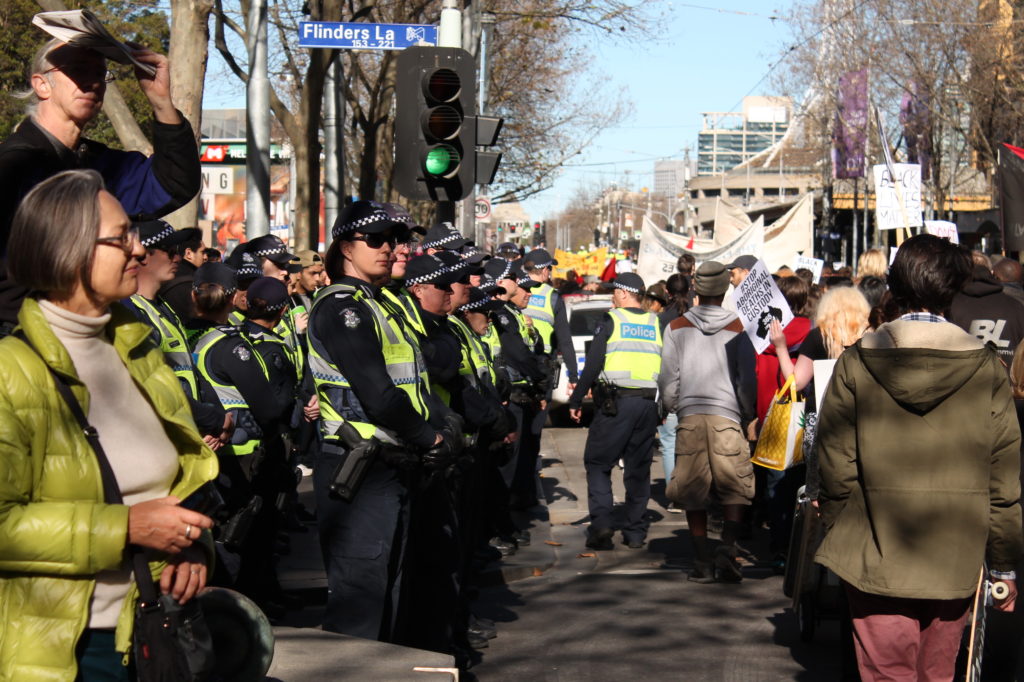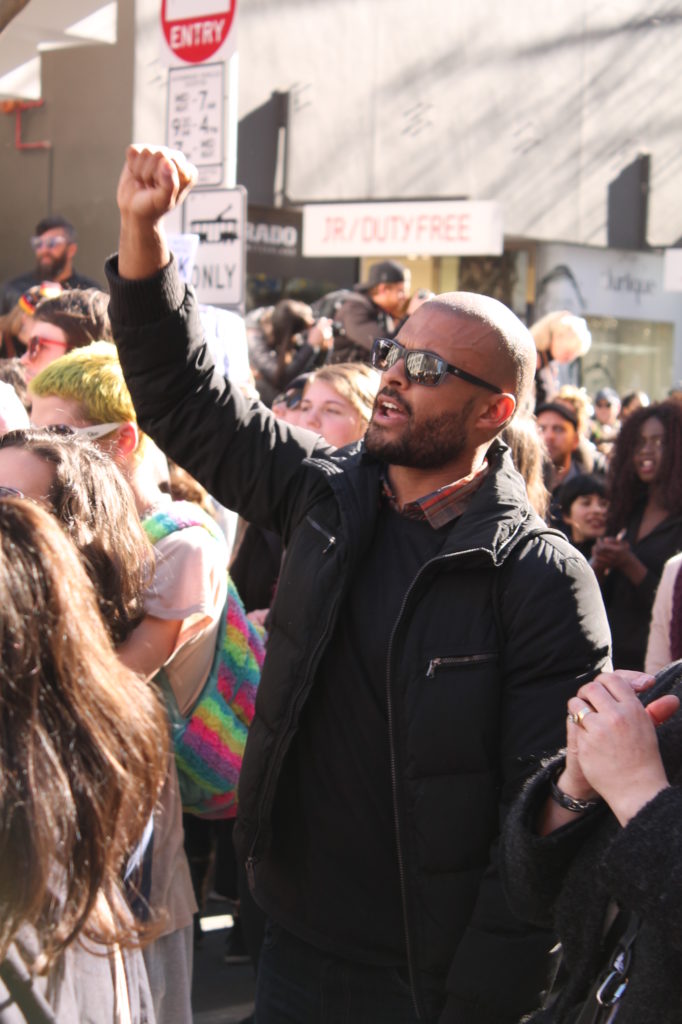Policing the Black Lives Matter Rally, Melbourne, 17th July 2016
The police presence at the Black Lives Matter (BLM) rally on Sunday 17 July, 2016 was notable for its sheer size and scale.*
Everyone at the event would have noticed the long lines of police arrayed around the initial rally gathering point at the State Library forecourt and the various PORT – Public Order Response Team units, manoeuvring through and around the crowd in tight formations, anticipating threats.
People on the march and every shopper passing by would have noted the long police cordons across each intersection along the march down Swanston Street all the way to the Flinders St intersection. They would have noticed the police horses (mounted branch) at the front and rear of the march and several large police broiler vans spaced along the route. They might have seen the dark blue units of special riot police, with helmets, visors and body armour that were ready and waiting. It was perhaps one of the largest – if not the largest single turn out of Victoria Police members for a peaceful protest march we had seen so far. Many of us had been to many far larger marches with only a fraction of the police presence.
Why the large police presence?
So why? Why was the level of police presence at this event, a peaceful protest rally and march, involving somewhere between three to four thousand people so notably large?
Almost all rallies and marches held in Melbourne’s CBD, and there may be several each week, have some level of police presence. Most often, police are present to observe, to ensure safety and facilitate movement through streets. Police tend to state that they are present only to ‘prevent a breach of the peace’ – which is an old but still very much utlised legal construct which is most often used as the justification for police interventions in public protest events and the use of force to contain or disperse a protest.
Regular observers of demonstrations and rallies would notice that the size and scale of the police presence differs, sometimes quite considerably. A small event might attract 3 or 4 police members standing by. Larger marches might have several hundred and the mounted branch is an unfortunate but regular feature at Melbourne protests.
Police make decisions about public order event planning based upon multiple factors. The Victorian Charter of Human Rights and Responsibilities for instance, protects rights to peaceful assembly and police in Victoria are obligated to uphold that. They will also make preparations based upon anticipated crowd numbers, the type of protest and the group organising the protest event. Overall, police aim to prepare for protest in such a way that they are able to maintain control whatever occurs at the rally. Having said that, police often make mistakes, misinterpret the situation and choose highly ineffective tactics. Their assessment of risk can be incorrect and the size and scale of their presence can therefore infringe upon the right to peaceful assembly in a variety of ways. There is a discussion of why police choose particular approaches at Activistrights.org.au.
Context Assessment
So what factors played into the Victoria Police assessment of this particular Black Lives Matter rally?
The shooting death of Alton Sterling in Louisiana and Philando Castile in Minnesota, both at the hands of US police officers, triggered the recent wave of protests in the United States over racialised policing. The Melbourne protest was called to “remember these lives lost, as well as to remember the Black victims of police brutality and state sanctioned violence in Australia.” Furthermore the killing of five white police officers during a protest in Dallas has raised tensions at Black Lives Matter protests throughout the US and that tension undoubtedly fed into both the media coverage and police assessment of the Melbourne protest event. Despite being overwhelmingly nonviolent, the policing of Black Lives Matter protests in the US has been brutal and violent in many occasions over the past few years. Police assessment would have been very conscious of this current political context.
Related to this was the threats from various new but increasingly visible far right groupings in and around Melbourne. The United Patriots Fronts and the True Blue Crew had both threatened the BLM rally on their respective social media feeds. The Facebook event page of the BLM Melbourne rally was inundated with racist and threatening posts, most quickly deleted but at a volume to suggest that counter protests, ether from individuals or groups were a distinct possibility. Police were monitoring these feeds and these would have played a key part of their assessment. Furthermore, police publicly referred to and referenced several other recent protest events over the past 12 months where physical clashes between far right and Antifa (anti-fascist) groups occurred.
“It is possible that some people may attend with the intent to disrupt the protest, urge violence or be confrontational. Given the history of violence that has occurred at a range of previous rallies, there will be a strong police presence in order to maintain public safety.” – Acting Assistant Commissioner Russell Barrett (Herald Sun)
Police often plan in reaction to previous events – in a similar way that activist groups do. As it happened, a very small contingent of far-right counter protesters did establish themselves at the State Library an hour or so before the main rally began. They were surrounded by a police cordon to separate them from the BLM rally participants and were shepherded away up Little Lonsdale Street by a phalanx of police just before the midday starting point of the main rally. This is consistent with policing at recent anti-racist and counter rallies which has aimed to keep opposing grouping physically apart using barriers and cordons. This dynamic, of police reacting to the threat of counter-protests with higher levels of controlling tactics, including weapon searches and the rise in the use of pepper-spray, is something that threatens to reduce our political protest ‘space’ even further.
Also prominent in the police assessment and planning, was the fact that the United States Vice Present Joe Biden happened to be in Melbourne on the same day as the BLM rally. At the time of the rally he would have been at or near the Melbourne Cricket Ground (MCG), a fairly long but plausible march from the CBD. Both police and Biden’s security would have been concerned, rightly or wrongly, that the Black Lives Matter march may have decided to target his visit. It is likely that the unusual police cordons along the east side of march route down Swanston Street were designed to prevent the rally turning east closer to the MCG. Likewise at the sit down occupation of the Flinders St intersection, two large police cordons also seemed designed to prevent a march east along Flinders Street in the direction of the MCG. As it was there were no plans to target Biden.
Lastly, numerous activists and observers have noted over many years that protests are policed differently along class and racial lines. Protests by or about indigenous rights, black deaths in custody or land rights in Australia have historically attracted a more interventionist and controlling level of policing than an equivalently sized non-indigenous protest. Political protests organized by Indigenous people or people of colour are more likely to face a high police presence than those organised by white or more mainstream organisations.
MALS has observed this over the past few years where peaceful, well organized and even solemn events such as the 2016 Invasion Day rally are very heavily policed despite there clearly being no plans for disruptive or violent action. Protests by Indigenous people or those perceived to be ‘radical’ are more likely to be treated as less predictable or more prone to violence by police. This dynamic mirrors the racialised and over-policing experienced on a day to day basis by Indigenous communities and by newly arrived Asian, Arabic, African and Islander communities. It has been well established that law enforcement globally is susceptible to unconscious or implicit bias when it comes to responding to people of colour, LGBTI or other radical communities of difference. Protest movements that embrace and embody diversity and that look and feel ‘different’ from the mainstream in terms of class, race and sexuality are more likely to be viewed with suspicion and hostility by police. It is likely that these bias come into play when police are assessing and planning for their public order operations. Police are more likely to hem in and seek to ‘control’ a protest they perceive to be radical, but tend to stand back and ‘allow’ or ‘facilitate’ a protest event by more mainstream, white or middle class groupings.
As stated by the rally organisors:
“BlackLivesMatter is a call to action and a response to the virulent anti-Black racism that permeates our society. Black Lives Matter is a unique contribution that goes beyond extrajudicial killings of Black people by police and vigilantes.” #BlackLivesMatter is a movement to create a society where Black peoples lives aren’t systematically and deliberately stopped short just because we are Black. #BlackLivesMatter is a rallying call for ALL Black peoples who seek liberation and justice.”
Even without the particular contextual factors mentioned above, (threat of counter protests, Joe Biden) it is possible that the radical political nature of this Black Lives Matter event, with its focus on racial justice and radical transformation of the criminal justice system and the nature of policing in society, may well have contributed to the sheer scale of the policing of the event.
So whats the problem?
So – what is the problem with a large police presence? It arguably deterred the United Patriots Front from openly attacking the rally. At one point at the Bourke St Mall police and riot police quickly surrounded and moved-on a couple of neo-nazis (yes, one had swastika tattoos) abusing the march from the sidelines. Police didn’t prevent the rally from marching. They stopped trams and traffic and tolerated the occupation of a major city intersection for several hours. So what’s the problem?
Well, the concerns are both practical and symbolic. At several points along the march lines of police effectively blocked people coming from those side streets entering the main march – thereby infringing upon their right of peaceful assembly. Although that wasn’t the intention of the cordons, most people are fearful of crossing a police line and an unknown number of people may have been prevented from entering the march from side streets.
For cordons and barriers that prevent access or egress to be lawful they need to be justified under law and reasonable under the circumstances. Whilst it may be justified (even if we don’t agree with it) for a police line to prevent protestors storming a building or opposing groups fighting – a line that prevents people joining a peaceful march is not.
Secondly, the presence of police makes people fearful. Protests that are led by rows of police horses and surrounded by police lines are less likely to be seen as safe or friendly by citizens observing them as they pass by or watching them on the news. It projects a view that this protest is dangerous or ‘could turn violent’. This is often deliberately telegraphed via and reinforced by the media. Indeed police made public pronouncements in the media in the days leading up to the rally suggesting parents not bringing children to this protest. “Victoria Police warn of Black Lives Matter protest violence” said one headline, all of which serves to deter participation, and makes protests smaller and more manageable.
Police presence connotes danger and criminality. When police assess a protest as ‘risky’ or ‘dangerous’ and surround it with horses and uniforms they project the idea that this protest cannot be trusted and needs to be controlled.
For popular movements to grow they must tap into widely shared societal values and draw greater numbers of ordinary people into their sphere. Popular support is a social movement’s greatest source of power to change and influence.
Police deter and alienate by their presence. When police surround a protest they effectively cut it off from one of its primary sources of support and sustainability; people. Protests, rallies and marches can and should feel like festivals, popular, grassroots people’s events that bring people together and draw people in. People who are sympathetic should be able to freely join in. Celebratory, angry or solemn they should express power and feel powerful.
It is a credit to the organisors and everyone who attended on Sunday that, despite the relentless conservative backlash against the #BLM movement, threats from the racist far right and the hundreds of police at every point, the rally and march remained large, powerful and successful.
Anthony Kelly is a member of Melbourne Activist Legal Support and the organiser of multiple Legal and Human Rights Observer teams since the World Economic Forum protests in 2001. These views are his own.
* Upon request from the organisers, MALS fielded a team of seven Legal Observers who were present at the BLM protest from 12pm to 3.00pm.




